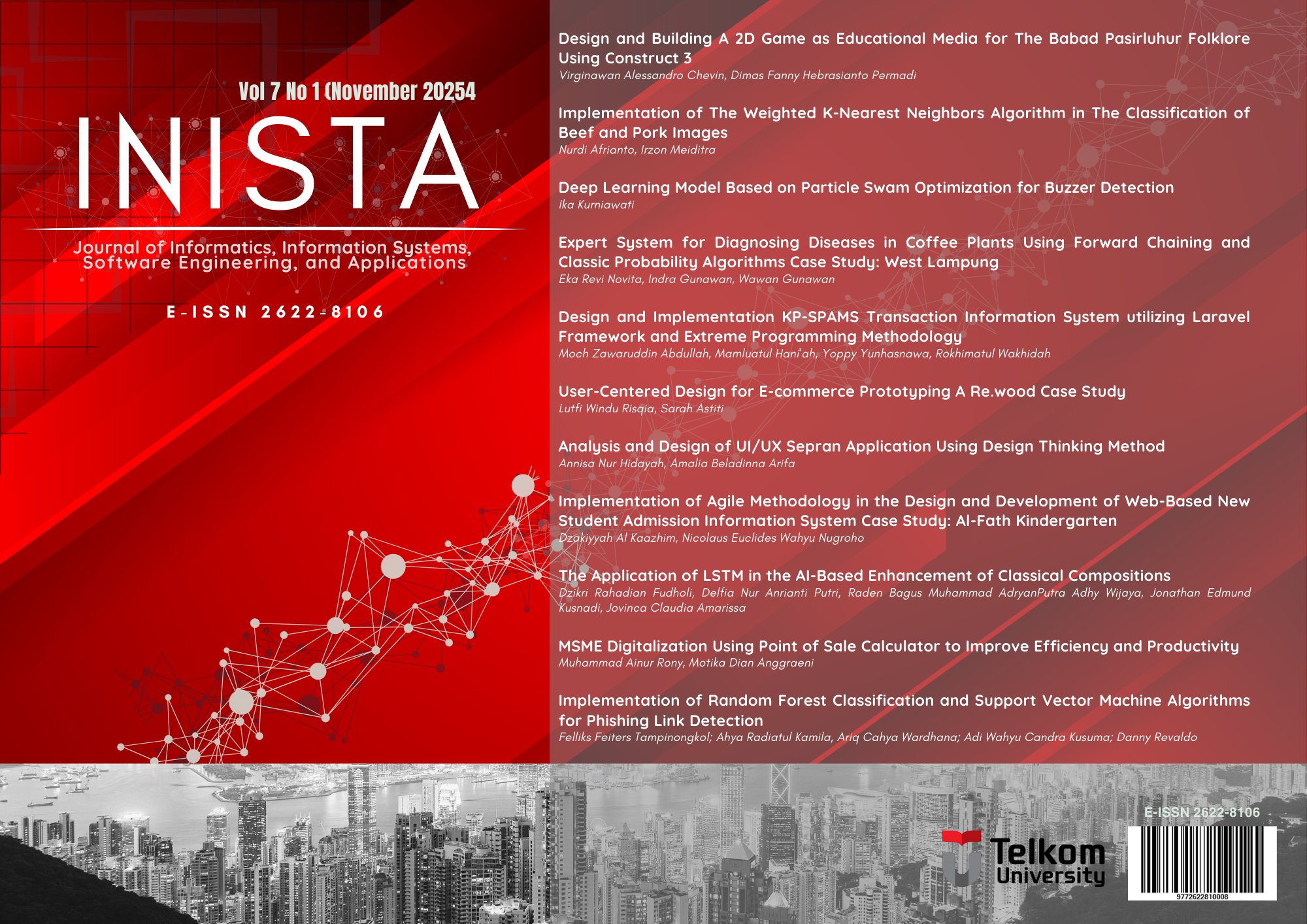Deep Learning Model Based on Particle Swarm Optimization for Buzzer Detection
Main Article Content
Abstract
Along with the development of the internet, the presence of buzzers is increasingly widespread on social platforms, especially on Twitter. Buzzers have played an important role in influencing and spreading misinformation, manipulating public opinion, and harassing and intimidating online social media users. Therefore, an effective detection algorithm is needed to detect buzzer accounts that endanger social networks because they affect neutrality. In this research, we propose a Deep Neural Network model to detect buzzer accounts on Twitter. We conducted experiments on 1000 datasets using PSO-based Deep Neural Network models and Ada Boost-based Deep Neural Networks to obtain the best model in detecting buzzer accounts. The results show that the performance of the PSO-based Deep Neural Network is the best with 98.90% accuracy compared to Ada Boost-based Deep Neural Network 95.30% or without feature weight and boosting algorithms with 46.60% accuracy. This clearly shows the superiority of our proposed method. These results are expected to help maintain neutral information on social media and minimize noise in the data that will be used for sentiment analysis research.
Article Details

This work is licensed under a Creative Commons Attribution-ShareAlike 4.0 International License.
Authors who publish with this journal agree to the following terms:
- Authors retain copyright and grant the journal right of first publication with the work simultaneously licensed under a Creative Commons Attribution License (CC BY-SA 4.0) that allows others to share the work with an acknowledgement of the work's authorship and initial publication in this journal.
- Authors are able to enter into separate, additional contractual arrangements for the non-exclusive distribution of the journal's published version of the work (e.g., post it to an institutional repository or publish it in a book), with an acknowledgement of its initial publication in this journal.
- Authors are permitted and encouraged to post their work online (e.g., in institutional repositories or on their website) prior to and during the submission process, as it can lead to productive exchanges, as well as earlier and greater citation of published work.
References
[2] F. N. Yudianto and Y. Sibaroni, “Klasifikasi Hashtag Buzzer/Bot Menggunakan Algoritma Random Forest dengan Atribut Komunitas untuk Mengurangi Disinformasi pada Twitter,” e-Proceeding Eng. , vol. 9, no. 3, pp. 1892–1901, 2022, [Online]. Available: www.trends24.in/indonesia/.
[3] C. Juditha, “Buzzer di Media Sosial pada Pilkada dan Pemilu Indonesia,” Semin. Nas. Komun. dan Inform., vol. 2019, pp. 199–212, 2019.
[4] B. Arianto, “Salah Kaprah Ihwal Buzzer: Analisis Percakapan Warganet di Media Sosial,” JIIP J. Ilm. Ilmu Pemerintah., vol. 5, no. 1, pp. 1–20, 2020, doi: 10.14710/jiip.v5i1.7287.
[5] A. Suciati, A. Wibisono, and P. Mursanto, "Twitter Buzzer Detection for Indonesian Presidential Election," ICICOS 2019 - 3rd Int. Conf. Informatics Comput. Sci. Accel. Informatics Comput. Res. Smarter Soc. Era Ind. 4.0, Proc., 2019, doi: 10.1109/ICICoS48119.2019.8982529.
[6] H. Ping and S. Qin, "A social bots detection model based on deep learning algorithm," Int. Conf. Commun. Technol. Proceedings, ICCT, vol. 2019-Octob, pp. 1435–1439, 2019, doi: 10.1109/ICCT.2018.8600029.
[7] A. Maulana and S. Kuswayati, “Klasifikasi Akun Buzzer Pemilu Pada Media Sosial Twitter Berdasarkan Data Tweet Menggunakan Algoritma C4.5,” Naratif J. Nas. Ris. Apl. dan Tek. Inform., vol. 3, no. 02, pp. 30–35, 2021, doi: 10.53580/naratif.v3i02.132.
[8] Catur Arpal Perkasa, Amalia Andjani Arifiyanti, and Agus Salim, “Klasifikasi Akun Buzzer Pada Twitter Menggunakan Algoritma Naive Bayes,” J. Ilm. Tek. Inform. dan Komun., vol. 3, no. 1, pp. 01–12, 2023, doi: 10.55606/juitik.v3i1.363.
[9] A. J. Panatra, F. B. Chandra, W. Darmawan, H. L. H. S. Warnars, W. H. Utomo, and T. Matsuo, "Buzzer Detection to Maintain Information Neutrality in 2019 Indonesia Presidential Election," Proc. - 2019 8th Int. Congr. Adv. Appl. Informatics, IIAI-AAI 2019, pp. 873–876, 2019, doi: 10.1109/IIAI-AAI.2019.00177.
[10] T. M. Khalil and Sahid, “Klasifikasi Informasi Hoaks pada Media Sosial Twitter menggunakan Algoritma Random Forest berbasis Particle Swarm Optimization,” J. Kaji. dan Terap. Mat., vol. 8, no. November, pp. 199–209, 2022.
[11] R. F. Amir, I. A. Sobari, and R. Rousyati, “Penerapan PSO Over Sampling Dan Adaboost Random Forest Untuk Memprediksi Cacat Software,” Indones. J. Softw. Eng., vol. 6, no. 2, pp. 230–239, 2020, doi: 10.31294/ijse.v6i2.9258.
[12] I. Kurniawati and H. F. Pardede, "Hybrid Method of Information Gain and Particle Swarm Optimization for Selection of Features of SVM-Based Sentiment Analysis," 2018 Int. Conf. Inf. Technol. Syst. Innov. ICITSI 2018 - Proc., pp. 1–5, 2018, doi: 10.1109/ICITSI.2018.8695953.
[13] Y. Liu, G. Wang, H. Chen, H. Dong, X. Zhu, and S. Wang, "An improved particle swarm optimization for feature selection," J. Bionic Eng., vol. 8, no. 2, pp. 191–200, 2011, doi: 10.1016/S1672-6529(11)60020-6.
[14] A. N. Rais, “Integrasi SMOTE Dan Ensemble AdaBoost Untuk Mengatasi Imbalance Class Pada Data Bank Direct Marketing,” J. Inform., vol. 6, no. 2, pp. 278–285, 2019, doi: 10.31311/ji.v6i2.6186.
[15] M. N. Baay, A. N. Irfansyah, and M. Attamimi, “Sistem Otomatis Pendeteksi Wajah Bermasker Menggunakan Deep Learning,” J. Tek. ITS, vol. 10, no. 1, 2021, doi: 10.12962/j23373539.v10i1.59790.
[16] P. P. Shinde and S. Shah, "A Review of Machine Learning and Deep Learning Applications," Proc. - 2018 4th Int. Conf. Comput. Commun. Control Autom. ICCUBEA 2018, pp. 1–6, 2018, doi: 10.1109/ICCUBEA.2018.8697857.
[17] J. Ahmad, H. Farman, and Z. Jan, Deep Learning Methods and Applications BT - Deep Learning: Convergence to Big Data Analytics. Springer Singapore, 2019. doi: 10.1007/978-981-13-3459-7.
[18] Goodfellow. I, Bengio.Y, Courville, A. Deep-learning. MIT Press, 2016. doi: 10.1038/s41566-018-0231-3.
[19] https://www.kaggle.com/datasets/goyaladi/twitter-bot-detection-dataset (accessed Jun. 27, 2024).
[20] A. Oppermann, "What is Deep Learning and How does it work? | Towards Data Science." https://towardsdatascience.com/what-is-deep-learning-and-how-does-it-work-2ce44bb692ac (accessed Sep. 14, 2024).
[21] Kennedy, J., & Eberhart, R. C. Particle swarm optimization. Proceedings of the IEEE International Conference on Neural Networks, 1942-1948, 1995.
[22] Yang, X.-S., & He, X. Particle Swarm Optimization: Basic Concepts, Variants, and Applications. Springer Handbook of Computational Intelligence. Springer, 2013.
